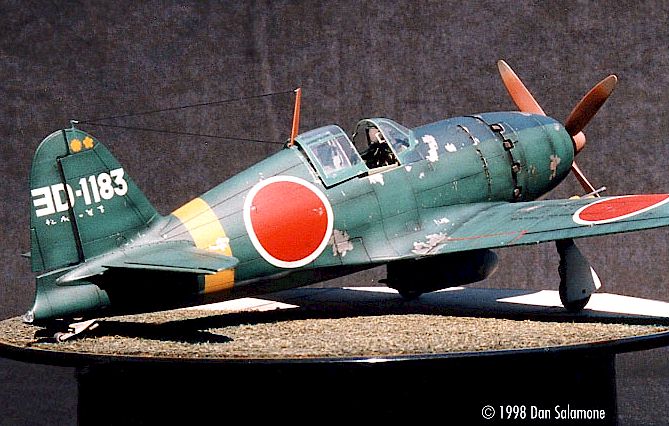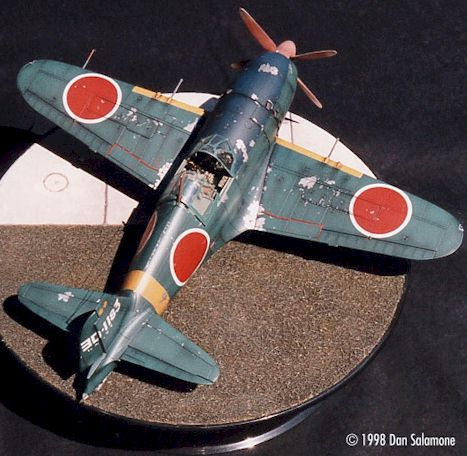|
Mitsubishi
J2M3 Model 21 Raiden |
|
Mitsubishi
J2M3 Model 21 Raiden |
B a c k g r o u n d |
The J2M Raiden (Thunderbolt) was developed as a land based interceptor. Designed by the
creator of the A6M Zero, Hiro Horikoshi, the Raiden hardly looked similar to it’s
more famous stable mate. Built for maximum speed and climb rate, the Raiden (Allied code
name Jack) also packed a powerful punch with four wing-mounted cannon. Remarkably only
around 500 of these powerful looking aircraft were built between 1943 and 1945, but they
did achieve success against the B-29 Superfortress. Later versions of the Raiden featured
an improved canopy which gave the pilot better visibility, and even a turbocharged
version. However, it was not enough to stop the onslaught of ever increasing Allied air
attacks on the Japanese home islands.
T h e K i t |
Hasegawa kit JT 35 was the basis for this project. Tamiya released a 1/48 Raiden kit many
years ago, and while a good kit, the newer Hasegawa offering has a beautiful cockpit. I
added some detail to this area in the form of some wiring and tubing, as well as drilling
out the lightening holes in the pilots’ seat. I also added the canopy slide rails
from sheet plastic. The cockpit detail was completed with the use of some items from
Reheat set #RH 110, Japanese accessory set. These included the rudder pedals, seat
harness, and canopy grab handles. Comparing the kit cockpit to photos in Famous Airplanes
of the World #61 it is my opinion that this is as nice an injection molded cockpit and
instrument panel as you will find.
The fit of the parts was very good with only a little tweaking of the wing/fuselage joint needed. I find that using Tenax 7R makes this process very easy. The way the kit is engineered is very well thought out, with most major parts coming together on panel lines, the exception being the forward fuselage decking. This area was molded to accept the different decking found on the various versions of the Raiden (J2M3, J2M5, etc.) and even here, minimal seam work was needed to get this model ready to paint.
The other modifications to the basic kit were as follows:
Finally, an aerial was made from invisible thread, and the canopy was cut open with a razor saw to show off the cockpit detail. The front windshield was the single worst fitting part of this kit- and that took about an extra two minutes to take care of.
This is the best all around model I have built from Hasegawa. It looks great in the box, and builds into an even better looking model. The Grace and Val kits look just as good if not better.
Without question, the competition between Tamiya and Hasegawa in 1/48 aircraft has
improved both the quality and subject matter found in these companies’ product lines.

C o l o r s a n d M a r k i n g s |
As stated earlier, this J2M3 from the 302nd NAG was equipped with an oblique 20mm cannon
near the wingroot under the port side of the cockpit. Other than that, this is a
"standard" Raiden as far as colors go.
Using Model Art Special #510, Camouflage and Markings of the Imperial Japanese Fighters in WWII as a reference, the colors are as follows. The upper surfaces were painted in dark green, similar to FS 34077. The lower surfaces were painted grey, FS 36307. I used a dark blue mixed with some white for a faded appearance of the anti-glare panel on top of the cowling and fuselage decking. Wing leading edge identification stripes and fuselage band were yellow FS 33538 and the propeller blades and spinner are tea brown, or FS 30111.
Here is where any uncertainty about this particular aircraft arise- the prop spinner may of been dark green instead of brown, it is not possible to tell from the black and white photo of this machine on page 28 of the above mentioned FAOW #61. It is quite possible this aircraft sported both color spinners during it’s service life- until a color photo would be found it is not possible to tell.
To finish out the colors, I used a pale green color to paint the cockpit, very similar to British interior green. Books can be written on the variations of cockpit colors found on Japanese aircraft, this shade is similar to what is known as "Nakajima green". The wheel well and inside of the landing gear doors were painted Floquil Japanese metal interior blue- or better known as aotake. This substance was a clear lacquer with blue or green color pigments added to determine the coverage of the thickness applied. This was used to help protect metal surfaces from corrosion and was found in cockpits, gear doors as well as inside wings and fuselages.
I painted these colors with Aeromaster, Model Master and Floquil enamel paints.
 All the markings come from Aeromaster sheet #48- 286, Empire
Defenders part 1. Note the unique kill markings used by the 302nd NAG that are at the top
of the rudder- they are yellow cherry-blossom flowers. All of the above paints and decals
were used without problems. Even though the photo of this Raiden, "YOD"- 1183
does not show excessive paint peeling, I used the model as a testbed to try a new (to me)
technique. This was painting the model silver over the primer, and after drying, taking a
clear masking agent and applying it in specific high wear areas on the airframe. I then
applied the camouflage colors, and when done, took masking tape and rubbing the tape down
over the areas I wanted "peeled" I ripped the tape off. It was not a subtle
technique, but it did remove the camouflage colors in a random and patch like fashion.
All the markings come from Aeromaster sheet #48- 286, Empire
Defenders part 1. Note the unique kill markings used by the 302nd NAG that are at the top
of the rudder- they are yellow cherry-blossom flowers. All of the above paints and decals
were used without problems. Even though the photo of this Raiden, "YOD"- 1183
does not show excessive paint peeling, I used the model as a testbed to try a new (to me)
technique. This was painting the model silver over the primer, and after drying, taking a
clear masking agent and applying it in specific high wear areas on the airframe. I then
applied the camouflage colors, and when done, took masking tape and rubbing the tape down
over the areas I wanted "peeled" I ripped the tape off. It was not a subtle
technique, but it did remove the camouflage colors in a random and patch like fashion.
After applying decals and clear coats, I used artists’ oils and pastel chalks to weather the model. Finally, the model was sprayed with another clear coat to seal the oils and chalks, small areas were "chipped" with a silver artists’ pencil, and the clear parts were glued on with RC 56, a flexible white glue that dries quickly.
I photographed the model in my backyard on a sunny afternoon using the tips found here on Hyperscale. I used my Nikon 6006 SLR mounted on a tripod, Kodak 200 ASA color print film and a remote shutter release cable. All settings were made manually- the first time this camera had not been used on full program mode.
C o n c l u s i o n s |
If you like Japanese WWII fighters, this kit is for you. What it lacks in camouflage
scheme possibilities it more than makes up in detail and engineering. I found the
following books invaluable resources in building this model:
1. Model Art Special #272 and #510- Camouflage and Markings of the Imperial
Japanese Navy Fighters of WWII.
#272 is the original issue, #510 being published with new information in 1997.
2. Famous Airplanes of the World #61, Navy Interceptor Raiden.
This book has an amazing amount of photos and detail shots that make this series of
books a great value- around 100 pages of material for roughly $6.00 U.S.
Some hobby shops carry these series of books, if not they can be purchased from many
sources on the Web, including Aviation Usk at: http://206.96.81.2:80/avusk/
or Hobby Link Japan at: http://iac.co.jp/~hlj/
Also, for anybody interested in Japanese aviation, visit Dave Pluths’site at: http://WWW.J-AIRCRAFT.COM/
or Hiroyuki Takeuchis’ site at: http://www.asahi-net.or.jp/~fk7h-tkuc/hp/english/index.html
Back to HyperScale Main Page
Back to Features Page